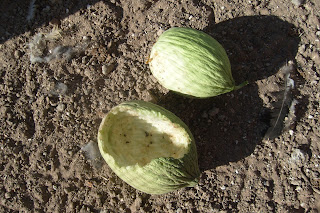Our most mature hen finally started laying a couple weeks ago. Let me tell you, that first time was an exciting day!
And so were the next few, because it took Red a while to get accustomed to it. I don't know exactly what happened or what went through her mind (do chickens think?) when she laid her first egg. But since I discovered it, broken, in the dirt of the chicken run one afternoon, I imagined Red didn't know it was coming or what to do about that feeling, that it came out unexpectedly and maybe she was even standing up (hence, the break). I was so glad to see none of the chickens had eaten it, and after that I paid close attention each morning. The next day Red made it to the nest box (smart chicken!), but either she or one of the others pecked it. So we didn't get that egg either. The next egg was also pecked, but not very deep, so I was able to salvage it. The following day, Red laid a "nude egg" (meaning it had no shell)--ugh. So we potentially had two problems: 1) Red needed to be broken of her egg-pecking tendencies, and 2) maybe she needed more calcium in her diet.
To address the first problem, I decided I needed to put golf balls in the nest box (an "old wives" remedy that often works) to train her to think eggs can't be pecked into anymore than golf balls. But I don't have any golf balls and didn't want to spend money on a pack of them when I only needed one or two. Then I spotted a couple of rocks about egg-sized that were also egg-shaped and thought it was worth a try. It worked! No more pecking.
The second potential problem I addressed by adding oyster shell to the chicken food, even though there is calcium in their feed--just to be safe. I don't know if that helped or not, but the shells are plenty tough now.
Pretty soon I noted that Red goes into the coop about the same time every morning and spends about half an hour in there. When she comes outside again, I know I can go in and collect her egg. What's funny is how the other two keep her company sometimes, while she's busy in there, as if encouraging her.
Last week, Daisy (the yellow one) started clucking so loud we could hear her from inside our house. It was pretty funny and went on and on, two mornings in a row. (My husband jokes that she was in "labor" for two days.) By the afternoon of the second day, she had laid her first egg, so we were excited all over again. Although, one day there was also a very smashed egg in the nest box (with only a bit of shell left to hint that it had really been an egg). A few days ago, Gizmo (the black and white) must have also laid an egg because we found three eggs that day. Now we just need to work on consistency!
The funnest surprise so far was the huge egg Red laid (on the right)--larger than a Large egg from the store (on the left):
Come to find out a couple days later, it was so big because it had two yolks!
(See the egg at the top of the picture with two yolks touching?)
I have also noticed how much yellower--sometimes even orange--the homegrown eggs are. In this picture the store bought egg is the big one on the left.
Homegrown eggs make this whole backyard chickens journey worth it!
















